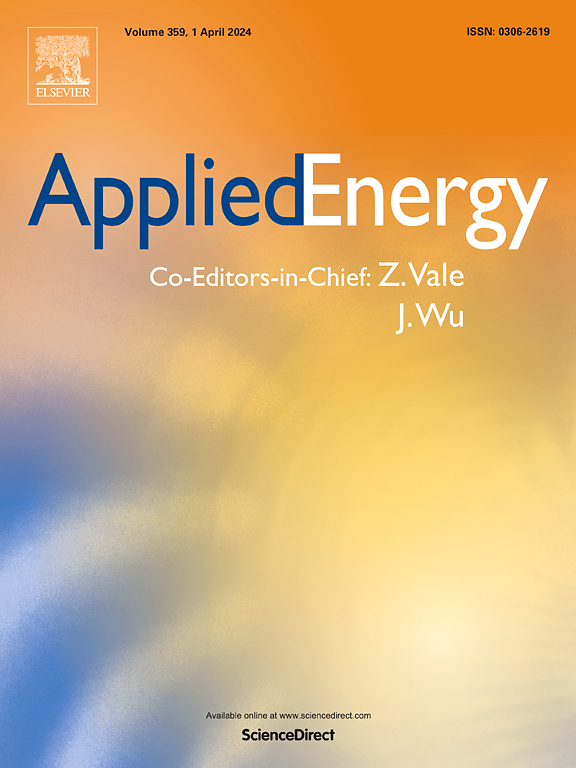通过模型预测控制保护住宅电气面板和服务:一项实地研究
IF 11
1区 工程技术
Q1 ENERGY & FUELS
引用次数: 0
摘要
住宅电气化——用电动机器取代化石燃料的电器和车辆——可以显著减少温室气体排放和空气污染。然而,在住宅建筑中安装电器或车辆充电会大大增加其电流消耗。在老房子里,大电流会危及电力基础设施,如断路器面板或电气服务(连接建筑物和配电网的电线)。升级电力基础设施往往需要长时间的延误和高昂的成本,因此对电气化构成了重大障碍。本文开发并现场测试了一种控制系统,通过将电气化家庭的总电流消耗保持在其现有面板和服务的安全范围内,从而避免了电气升级的需要。在提出的控制体系结构中,高级控制器在滚动预测范围内规划设备设定点,而低级控制器监控实时情况并在必要时降低设备。该控制系统在一所全电气化单户住宅中进行了测试,该住宅具有最低标准的绝缘,空气对空气热泵和用于空间调节的备用电阻热,电阻热水器和I级(1.8 kW)充电的插电式混合动力汽车。现场测试持续了31个冬季,室外温度低至-20°C。该控制系统仅通过调节热泵和热水器的温度设定点,将整个家庭的电流维持在电气面板的安全范围内,并将服务额定为100 A,这是北美老房子的常见额定。模拟表明,同样的100a限制可以容纳第二辆二级(11.5千瓦)充电的电动汽车。如果法规允许,拟议中的控制系统可以让老房子在不升级电板或服务的情况下安全地通电,为一个普通家庭节省2000到1万美元。本文章由计算机程序翻译,如有差异,请以英文原文为准。
Protecting residential electrical panels and service through model predictive control: A field study
Residential electrification – replacing fossil-fueled appliances and vehicles with electric machines – can significantly reduce greenhouse gas emissions and air pollution. However, installing electric appliances or vehicle charging in a residential building can sharply increase its current draws. In older housing, high current draws can jeopardize electrical infrastructure, such as circuit breaker panels or electrical service (the wires that connect a building to the distribution grid). Upgrading electrical infrastructure often entails long delays and high costs, so poses a significant barrier to electrification. This paper develops and field-tests a control system that avoids the need for electrical upgrades by maintaining an electrified home’s total current draw within the safe limits of its existing panel and service. In the proposed control architecture, a high-level controller plans device set-points over a rolling prediction horizon, while a low-level controller monitors real-time conditions and ramps down devices if necessary. The control system was tested in an occupied, fully electrified single-family house with code-minimum insulation, an air-to-air heat pump and backup resistance heat for space conditioning, a resistance water heater, and a plug-in hybrid electric vehicle with Level I (1.8 kW) charging. The field tests spanned 31 winter days with outdoor temperatures as low as -20 °C. The control system maintained the whole-home current within the safe limits of electrical panels and service rated at 100 A, a common rating for older houses in North America, by adjusting only the temperature set-points of the heat pump and water heater. Simulations suggest that the same 100 A limit could accommodate a second electric vehicle with Level II (11.5 kW) charging. If codes permit, the proposed control system could allow older homes to safely electrify without upgrading electrical panels or service, saving a typical household on the order of $2,000 to $10,000.
求助全文
通过发布文献求助,成功后即可免费获取论文全文。
去求助
来源期刊

Applied Energy
工程技术-工程:化工
CiteScore
21.20
自引率
10.70%
发文量
1830
审稿时长
41 days
期刊介绍:
Applied Energy serves as a platform for sharing innovations, research, development, and demonstrations in energy conversion, conservation, and sustainable energy systems. The journal covers topics such as optimal energy resource use, environmental pollutant mitigation, and energy process analysis. It welcomes original papers, review articles, technical notes, and letters to the editor. Authors are encouraged to submit manuscripts that bridge the gap between research, development, and implementation. The journal addresses a wide spectrum of topics, including fossil and renewable energy technologies, energy economics, and environmental impacts. Applied Energy also explores modeling and forecasting, conservation strategies, and the social and economic implications of energy policies, including climate change mitigation. It is complemented by the open-access journal Advances in Applied Energy.
 求助内容:
求助内容: 应助结果提醒方式:
应助结果提醒方式:


